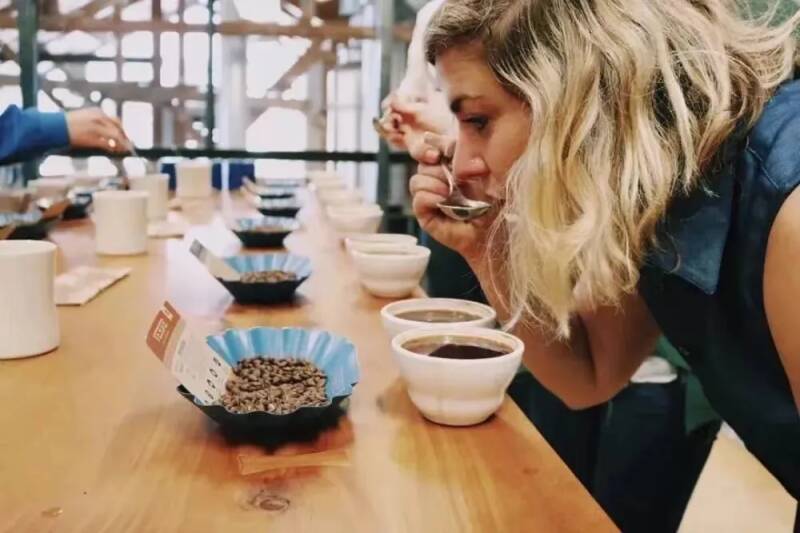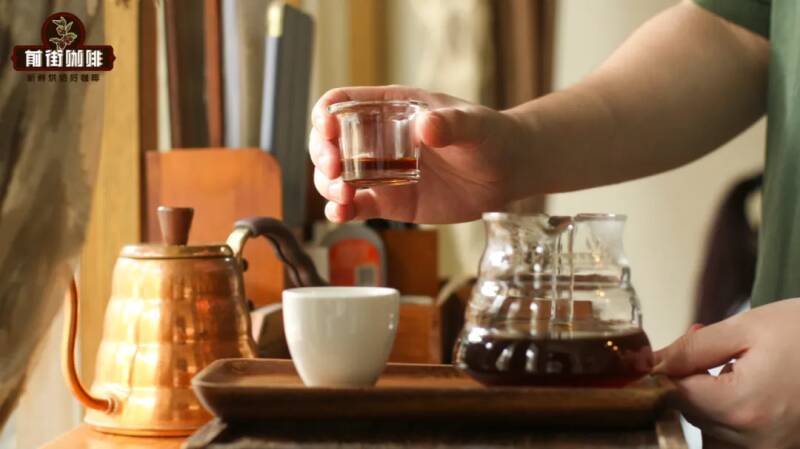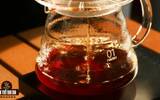How to adjust the extraction efficiency of hand-brewed coffee? Why would a barista take a sip of your coffee before serving it?
In the field of coffee, there is always some behavior that makes outsiders feel bizarre. For example, many people will share a cup of coffee, or drink coffee with a spoon instead of a cup, or make a "whining" sound when drinking coffee, and so on. This kind of behavior phenomenon makes friends outside the circle feel incredible and difficult to understand. But in fact, these behaviors are actions or links for better coffee tasting.

These behaviors are relatively rare in daily life, after all, cup testing, or sharing meetings are not held all the time. To say that the most common behavior that makes it difficult for outsiders to understand is this: when you go to a cafe and order a cup of hand-made coffee, after the barista has finished making it, he doesn't bring it to you immediately. Instead, he poured out a small cup for himself to drink, and then handed you your coffee. In fact, not only outsiders, Qianjie believes that when you first stepped into the coffee circle, you must have had the same question: "Why do some baristas pour a cup for themselves before making a product?"

Why do baristas pour themselves a drink before making the product? Reasonable, this behavior is very simple to explain, can be summarized in one sentence, that is: in order to maintain the stability of the product!
Although hand-brewing coffee looks relatively simple, it actually requires a lot of attention. Some subtle changes in the main body of the extraction (coffee beans) will change the taste of the coffee.
Changes in the state of beans freshly baked coffee beans will be very rich in carbon dioxide, too rich it will reduce the extraction efficiency, hot water can not fully extract the flavor substances in the coffee. But fortunately, carbon dioxide does not remain in coffee beans all the time.
It will flow out all the time and slowly through the body of coffee beans "riddled with holes" due to roasting, and because of this, the state of coffee beans will change every day. Under the same brewing method, the taste of coffee brewed from the same coffee bean after a few days will be different. Because of the difference in carbon dioxide content of beans, the extraction efficiency received by beans is different when other parameters and methods are not changed, resulting in differences in taste.
Therefore, baristas need to try first to determine whether the extraction rate of this cup of coffee is up to the standard and whether the concentration is appropriate, and then decide whether to present it to the guests. If some irreversible negative effects are found in the taste of this small cup of coffee, such as insufficient or excessive extraction, the barista will choose to remake the coffee until the coffee meets the standard of production and then presented to the guest.
But in fact, guests who often visit Qianjie stores will find that Qianjie does not pour out a small cup and take a sip when making guests' hand flushes. Not only on the front street, but also in many coffee shops. Why? Because in the final analysis, what brings about change is the ever-changing state of coffee beans. As long as we learn how to control the extraction efficiency during brewing according to the current state of beans, we can stabilize the taste of coffee.
How to ensure the stability of coffee production? But before that, we need to choose a set of suitable cooking parameters according to the baking degree and treatment of the beans, which is necessary! Choosing the right brewing parameters is equivalent to laying a good extraction foundation, no matter how the substance in the bean changes (during the taste period), the taste of the coffee will only be slightly affected, and the taste will always be in a stable range. In order to eliminate the effects of carbon dioxide as much as possible, as mentioned earlier, we need to learn to control the extraction efficiency according to the state of the beans during cooking!
When steaming, the powder bed and the speed of launching can be used as objects to observe! For example, when the powder bed shows that the coffee is in a relatively "fresh" state, it means that a higher extraction efficiency is needed for extraction, because the presence of carbon dioxide will increase the obstacles to extraction! In that case, we can extend the extraction time by manipulating the flow of water, so that the hot water has a higher extraction efficiency and reduce the impact of too much carbon dioxide; and if the performance of the powder bed is not so "active", that is, beans that have been kept for a long time, then we can shorten the extraction time to prevent coffee from being overextracted because of the high extraction efficiency of other parameters. In addition, there are other details that can be paid attention to, but in general, learn to improvise. And the main attention is that the beans outside the appreciation period, the beans during the appreciation period will not change too much, stable brewing, stable parameters can stably brew delicious coffee. So, again, as long as you fully understand the extraction principle of coffee, you can cook it into delicious dishes no matter how the beans change.
-END-
Important Notice :
前街咖啡 FrontStreet Coffee has moved to new addredd:
FrontStreet Coffee Address: 315,Donghua East Road,GuangZhou
Tel:020 38364473
- Prev

Introduction to Las Nieves Estate, Mexico's 2024 COE Sun-Denise Treatment Group Champion
In North America, coffee is grown in many countries, such as El Salvador, Honduras, Costa Rica, Mexico, etc. due to their suitable geographical environment and other conditions. Among them, Mexico is the tenth largest coffee producer in the world, and in recent years, many excellent coffee beans have been produced. Mexio Mexico
- Next

How does the thickness of coffee powder affect the speed at which coffee is discharged? What are the differences between filter papers of different brands of filter cups?
Two days ago, we mentioned the importance of extraction time. The extraction time is the total time used for hot water to extract coffee. The length of time determines the amount of substances extracted by hot water, so the extraction time is very important. The extraction time is determined by the penetration rate of hot water. When the penetration rate of hot water is faster, the extraction time will decrease.
Related
- What effect does Italian American coffee with filter paper have? Will coffee taste better if it is put on filter paper at the bottom of the powder bowl?
- What is the color difference in coffee beans? What are the characteristics of honey processed coffee beans? Why are the anaerobically treated coffee beans uneven in color?
- How does novice Xiaobai quickly get started and make coffee? Newbies learn to make coffee by hand and share the specific steps and process process!
- Costa tea has a shelf life of 100 years?! Expert: Unable to verify
- It's a huge uproar! American milk addition was rejected by Manner employees?!
- Mocha pot coffee bean recommendations| How fine and how much powder should be used for grinding? What parameter ratios do I need to use to make milk with Mocha pot coffee?
- What are the characteristics of the world's top ten coffee beans treated with Costa Rica honey? How to make black honey kadura from Tarazhu Pilon Processing Plant taste good?
- How to make deep-roasted coffee? What grinding water temperature does authentic Jamaica Blue Mountain No. 1 coffee use to brew it well?
- Selected high-grade rose summer coffee flavor tasting guide Why Panama rose summer has the aroma of flowers and fruits
- What equipment does a novice Xiaobai need to buy to learn to make coffee? Filter cup electronic scale bean grinder manual flushing pot purchase guide

